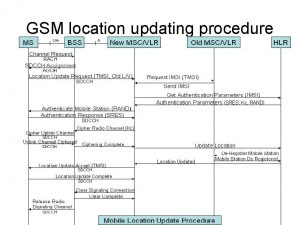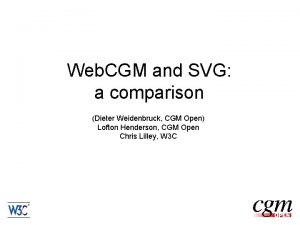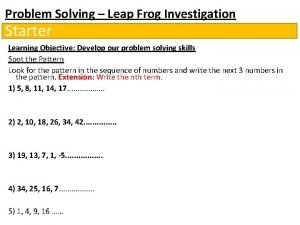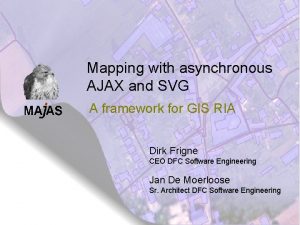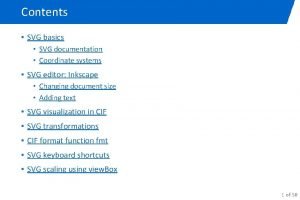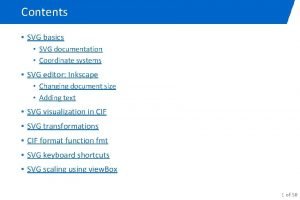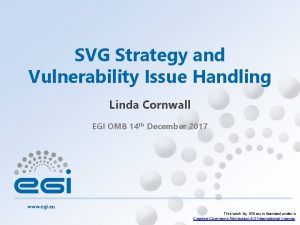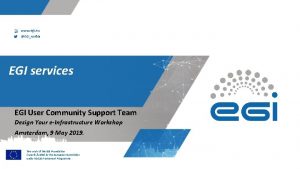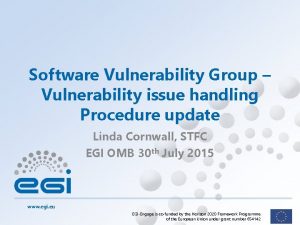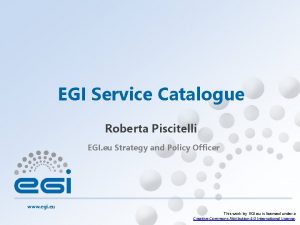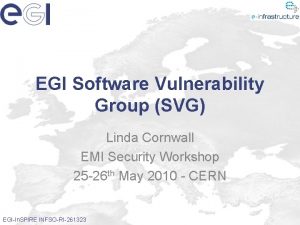EGI SVG Strategy and issue handling procedure update
















- Slides: 16

EGI SVG Strategy and issue handling procedure update Linda Cornwall, STFC OMB 27 th July 2017 www. egi. eu This work by EGI. eu is licensed under a Creative Commons Attribution 4. 0 International License.

Purpose of the EGI Software Vulnerability Group (SVG) • "To minimize the risk to the EGI infrastructure arising from software vulnerabilities". – This document describes what SVG does to fulfil this • Largest activity is handling software vulnerabilities reported – Issue handling procedure is included in this document – Includes a lot of details for SVG, software providers, reporters etc. – Procedure itself will be on the wiki (will be placed in SEC 02) • Then people may refer to this document for more explanation 9/6/2021 EGI SVG Issue Handling update 2

Main changes • Small change to Critical/High risk boundary • Detailed recommended steps for ‘Critical’ risk vulnerabilities when fix not available. • More on lack of homogeneity, and possible steps • 4 different types of notification • CMD handled similarly to UMD • Improved the Software Checklist • General improvement to descriptions Document at: -https: //documents. egi. eu/secure/Show. Document? docid=3145 9/6/2021 EGI SVG Issue Handling update 3

Reminder - Basic Method of handling vulnerabilities reported • Anyone may report an issue by e-mail to report-vulnerability@egi. eu • If it has not been announced, SVG contacts the software provider and the software provider investigates (with SVG member, reporter, others) • The relevance and effect in EGI are determined • If relevant to EGI the risk in the EGI environment is assessed, and put in 1 of 4 categories – ‘Critical’, ‘High’, ‘Moderate’ or ‘Low’ • If it has not been fixed, Target Date (TD) for resolution is set - ‘High’ 6 weeks, ‘Moderate’ 4 months, ‘Low’ 1 year • Advisory is issued by SVG – If the issue is ‘Critical’ or ‘High’ in the EGI infrastructure – When the vulnerability is fixed if EGI SVG is the main handler of vulnerabilities for this software, or software is in EGI Repository regardless of the risk. – If we think there is a good reason to issue an advisory to the sites. • CSIRT monitors for ‘Critical’ and ‘High’ risk vulnerabilities 9/6/2021 EGI SVG Issue Handling update 4

Critical/High boundary (1) • If a vulnerability is considered ‘Critical’ on the assumption that a exploit is publicly available – In the past we have set to ‘Critical’ if we expect this to happen in a day or two – Now start as ‘High’ with a warning that it is likely to become ‘Critical’, and then elevate to ‘Critical’ if/when the exploit is made available. • One case in 2016 where we went ‘Critical=>High’ as exploit was not released 9/6/2021 EGI SVG Issue Handling update 5

Critical/High boundary (2) • If a vulnerability is considered ‘Critical’ in middleware on the assumption that information is available publicly, and it’s difficult to find, rather contrived – – Start as ‘High’ Give people 4 weeks rather than 2 to patch when fixed Remove vulnerable versions from repositories Elevate to ‘Critical’ if becomes public Critical becomes incident likely in coming days if no action is taken 9/6/2021 EGI SVG Issue Handling update 6

Critical vulnerabilities – especially where fix is not available • Most vulnerabilities which are assessed as ‘Critical’ are announced by the technology provider • However some are not – Zero day – Those found and reported to EGI • In the past we have said ‘handle on case by case’ • Now we have added steps which may be carried out – Learnt from the VOMS Admin experience – Makes it easier – Includes telecon to discuss 9/6/2021 EGI SVG Issue Handling update 7

Critical vulnerability – Contacting management • SVG may decide to contact management • Makes sense to inform management if there is a critical vulnerability with widespread implications • May ask management’s opinion – E. g. if more than 1 option – E. g. Big risk to do nothing, major impact on infrastructure to stop a service – But we should say what we recommend • SVG’s decision whether to contact management – management has ultimate responsibility for security – Delegated to the security teams 9/6/2021 EGI SVG Issue Handling update 8

Less homogeneity • Sometimes difficult to assess the risk – Lack of SVG RAT knowledge – We don’t know the configuration at sites • Option of ‘Up to High’ risk advisory – If we think its likely to be ‘High’ for some configs in EGI • Option of ‘Alert’ rather than an advisory – Alerting people to a problem, asking for feedback, not specifically advising people what to do. 9/6/2021 EGI SVG Issue Handling update 9

4 types of e-mail • ‘HEADS UP’ – Sites may be asked to do something urgently soon. – Usually only for vulnerabilities which may be a ‘Critical’ • ‘ADVISORY’ – Sites instructed to do something – The Commonest type of mail, e. g. update when vulnerability fixed in software • ‘ALERT’ – Sites should be aware – This may be important to you, you may want to take action. Often ask for feedback • ‘INFORMATION’ – to inform sites of something – E. g. if a well talked about vulnerability is not relevant 9/6/2021 EGI SVG Issue Handling update 10

Federated Cloud • EGI CMD is now live – We handle vulnerabilities in this distribution in the same way as we do for the UMD • VM endorser/Owner lists still needed • VM Operator lists still needed. • Some further improvement to Cloud vulnerability handling probably still needed – Maybe later 9/6/2021 EGI SVG Issue Handling update 11

Software Security Checklist • List of things to consider for those selecting or writing software – To help reduce the likelihood of security problems – None guarantee security • Still 9 points to consider • This has been tidied • Included reference to the EGI data protection policy 9/6/2021 EGI SVG Issue Handling update 12

Not included • Re-organisation of the document – Some would prefer it to be shorter – But info in it is useful, detailed description of what we do – Done an update rather than re-write • Further Co-operation with other infrastructures – How do we do things jointly? • We are working on this • But do propose an e-mail list for ‘WHITE’ information, which anyone can join – AMBER later 9/6/2021 EGI SVG Issue Handling update 13

In addition • Sites should NOT be penalized for downtime due to carrying out requests from the security teams – Updating software due to advisory – Taking down services – Any action requested by CSIRT • More general than SVG 9/6/2021 EGI SVG Issue Handling update 14

9/6/2021 EGI SVG Issue Handling update 15

Thank you for your attention. Questions? www. egi. eu This work by EGI. eu is licensed under a Creative Commons Attribution 4. 0 International License.

